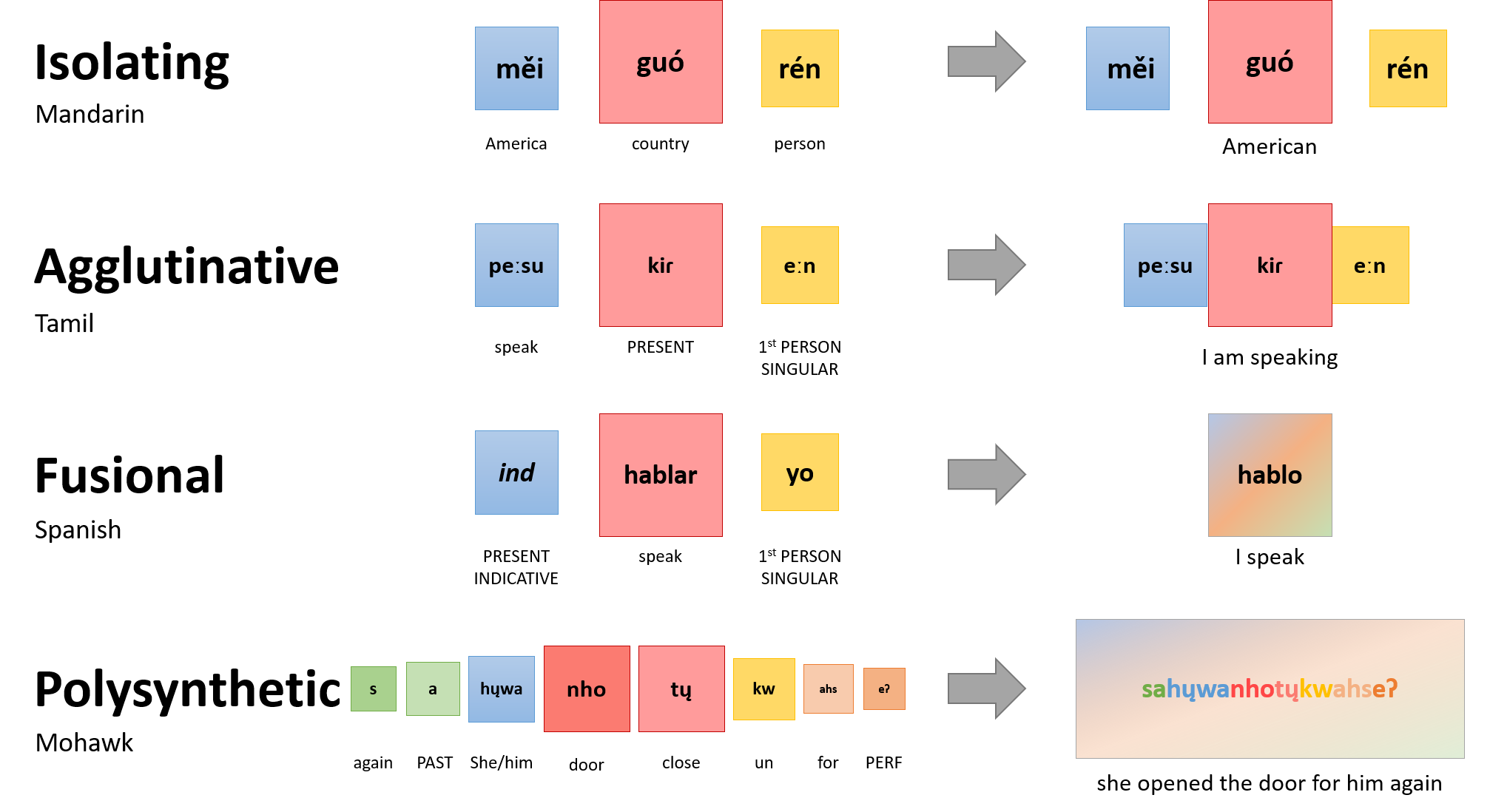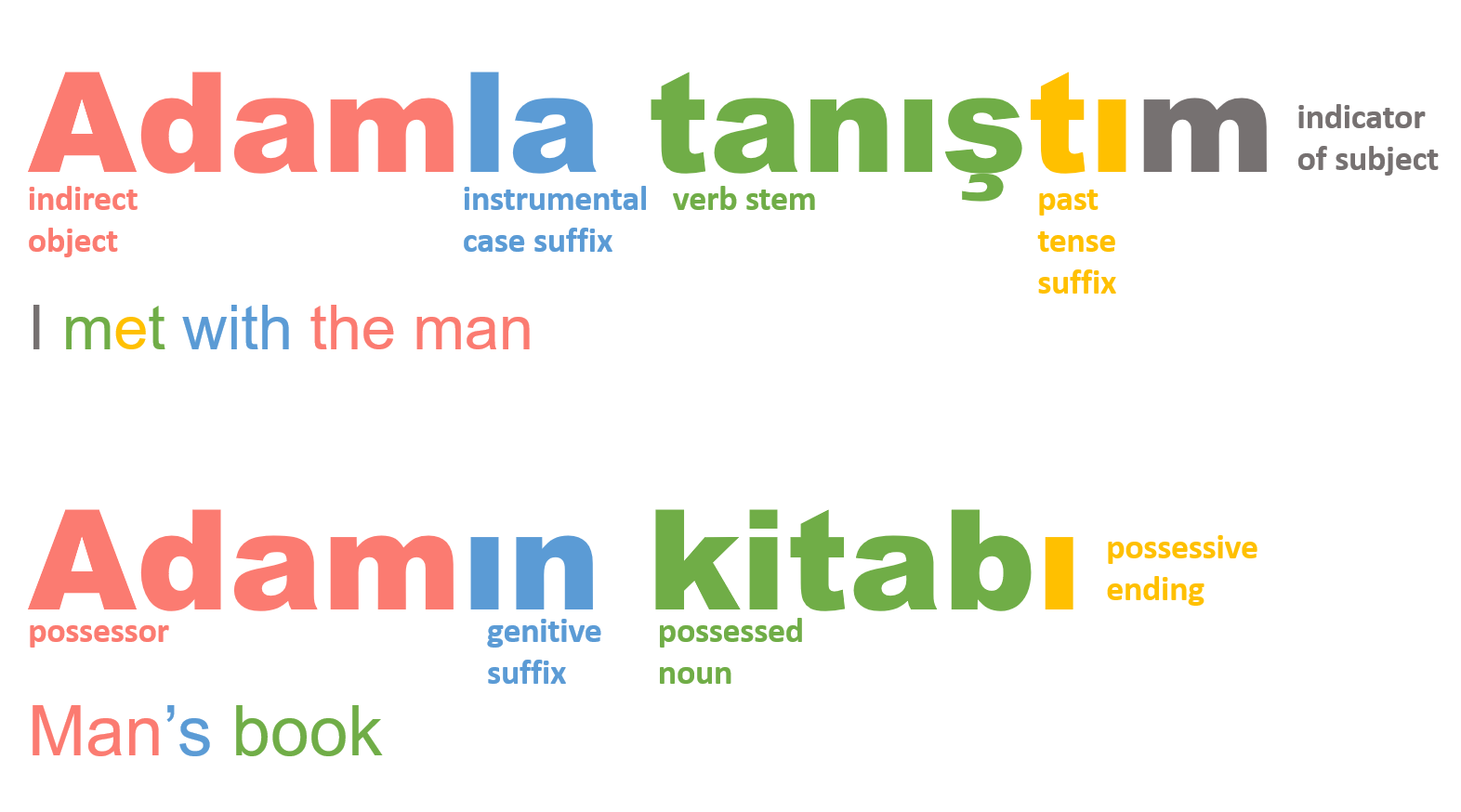An agglutinative language is a type of synthetic language with morphology that primarily uses agglutination.
Agglutinative language - Wikipedia
There's lots of language to unpack there!
MORPHEME:
A morpheme is the smallest meaningful constituent of a linguistic expression.[1] The field of linguistic study dedicated to morphemes is called morphology.
In English, morphemes are often but not necessarily words. Morphemes that stand alone are considered roots (such as the morpheme cat); other morphemes, called affixes, are found only in combination with other morphemes. For example, the -s in cats indicates the concept of plurality but is always bound to another concept to indicate a specific kind of plurality.[2]
This distinction is not universal and does not apply to, for example, Latin, in which many roots cannot stand alone. For instance, the Latin root reg- ('king') must always be suffixed with a case marker: rex (reg-s), reg-is, reg-i, etc. For a language like Latin, a root can be defined as the main lexical morpheme of a word.
These sample English words have the following morphological analyses:"Unbreakable" is composed of three morphemes: un- (a bound morpheme signifying "not"), break (the root, a free morpheme), and -able (a bound morpheme signifying "an ability to be done").[3][4][5]
The plural morpheme for regular nouns (-s) has three allomorphSYNTHETIC LANGUAGE:
A synthetic language is a language which is statistically characterized by a higher morpheme-to-word ratio. In contrast to analytic languages, which break up concepts into separate words, synthetic languages combine (synthesize) them into a single word.
- international classical compounds based on Greek and Latin derivational synthesis
high
cholesterol
blood
the presence of high levels of cholesterol in the blood.
Synthetic language - Wikipedia
Going beyond Wikipedia:
Agglutinative languages form words through the combination of smaller morphemes to express compound ideas. Each of these morphemes generally has one meaning or function and retains its original form and meaning during the combination process. For languages that have agglutinative morphology, such as Turkish, Finnish, Hungarian, or Korean, it is possible to produce thousands of forms for a given root word.
The following table shows a list of inflected forms for the Finnish word "talo" ("house").
| Word | Translation |
|---|---|
| Talo | House |
| Taloni | My house |
| Talossa | In the house |
| Talossani | In my house |
| Taloja | Houses |
| Taloissa | In the houses |
Inflected languages, such as English, French, and Latin, have a very small number of possible word forms for a given root word. In inflected languages, morphemes influence one another when binding. Most changes in inflection are present in the stem or word ending. In contrast to agglutinative languages, inflected languages tend to have different functions for a single morpheme. For example, a morpheme can determine both number and case.
Agglutinative Languages | Microsoft Learn
And:
Agglutinating language is a language which has a morphological system in which words as a rule are polymorphemic and where each morpheme corresponds to a single lexical meaning.
Examples
Classical examples of agglutinating languages are Turkish and Quechua.
(i) Turkish
ev- ler- i- den house PL- POSS- ABL 'from their house'
(ii)Quechua
maqa- chi- naku- rka- n beat CAUS- RECP- PL- 3 'They let each other be beaten.'
Agglutinating language - Glottopedia
LANGUAGE TYPES: AN OVERVIEW:
The way in which morphemes are employed to modify meaning can vary between languages. is a method used by linguists to classify languages according to their morphological structure. While a variety of classification types have been identified, we will look at a common method of classification: analytic, agglutinative and fusional. Figure 3.2 give some examples of morphological typology across the world’s languages.
have a low ratio of morphemes to words. They are often in that each morpheme is also a word and vice versa. These languages create sentences with independent root morphemes with grammatical relations between words being expressed with separate words. Examples of analytics or isolating languages include Chinese languages and Vietnamese. While in English we inflect numbers: one day, two days, an analytic language such as Mandarin Chinese has no inflection: 一天, yì tiān “one day”, 三天, sān tiān “three day”. The Canadian linguist and translator Sonja Lang has created an analytic language, Toki Pona, as a minimalist creative endeavour.

Unlike analytic languages, synthetic languages employ inflection or agglutination to express syntactic relationships. combine one or more morphemes into one word. The distinguishing feature of these languages is that each morpheme is individually identifiable as a meaningful unit even after combining into a word. Examples of agglutinative languages include Tamil, Secwepemc, Turkish, Japanese, Finnish, Basque and Hungarian. Figure 3.3 shows you an example of agglutination in Turkish. Each coloured morpheme is also given an approximate English translation. Figure 3.2 give another example from Tamil.

Another type of synthetic languages are . Like agglutinative languages, fusional languages also combine morphemes to modify meaning. However, these combinations often do not remain distinct and fuse together. In addition, these languages also have a tendency to use a single inflectional morpheme to denote numerous grammatical or syntactic features. For example, the suffix -í in Spanish comí (“I ate”) denotes both first-person singular agreement and preterite tense. Examples of fusional languages include Indo-European languages such as Sanskrit, Spanish, Romanian, and German. Modern English could also be considered fusional; although it has tended to evolve to be more analytic. J. R. R. Tolkien’s fictional language Sindarin is fusional (another elvish language, Quenya, is agglutinative).
Figure 3.2 shows an additional morphological type named . These languages tend to a high morpheme-to-word ratio as well as regular morphology. They often combine a large number of morphemes to form words that are the equivalent of entire sentences in other languages. Many languages in North America such as Mohawk tend to have this type of morphology.
3.3 Morphology of Different Languages – Psychology of Language
.
.
.
No comments:
Post a Comment